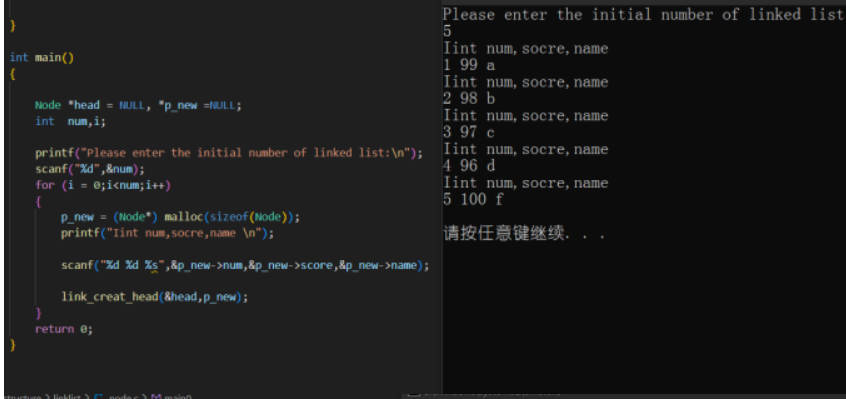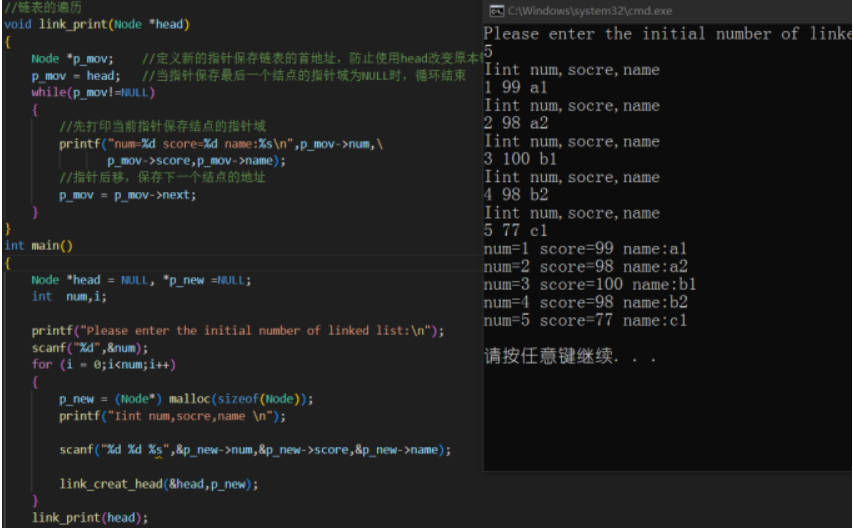RTOS内核 FreeRTOS 链表项
FreeRTOS 列表 列表项(链表 节点)
链表与数组区别

链表是通过节点把离散的数据链接成一个表,通过对节点的插入和删除操作从而实现对数据的存取。
数组是通过开辟一段连续的内存来存储数据,这是数组和链表最大的区别。
数组的每个成员对应链表的节点,成员和节点的数据类型可以是标准的C 类型或者是用户自定义的结构体。
数组有起始地址和结束地址,而链表是一个圈,没有头和尾之分,但是为了方便节点的插入和删除操作会人为的规定一个根节点(头节点)。
FreeRTOS 列表与列表项
list.c
/*
* FreeRTOS Kernel V10.5.1
* Copyright (C) 2021 Amazon.com, Inc. or its affiliates. All Rights Reserved.
*
* SPDX-License-Identifier: MIT
*
* Permission is hereby granted, free of charge, to any person obtaining a copy of
* this software and associated documentation files (the "Software"), to deal in
* the Software without restriction, including without limitation the rights to
* use, copy, modify, merge, publish, distribute, sublicense, and/or sell copies of
* the Software, and to permit persons to whom the Software is furnished to do so,
* subject to the following conditions:
*
* The above copyright notice and this permission notice shall be included in all
* copies or substantial portions of the Software.
*
* THE SOFTWARE IS PROVIDED "AS IS", WITHOUT WARRANTY OF ANY KIND, EXPRESS OR
* IMPLIED, INCLUDING BUT NOT LIMITED TO THE WARRANTIES OF MERCHANTABILITY, FITNESS
* FOR A PARTICULAR PURPOSE AND NONINFRINGEMENT. IN NO EVENT SHALL THE AUTHORS OR
* COPYRIGHT HOLDERS BE LIABLE FOR ANY CLAIM, DAMAGES OR OTHER LIABILITY, WHETHER
* IN AN ACTION OF CONTRACT, TORT OR OTHERWISE, ARISING FROM, OUT OF OR IN
* CONNECTION WITH THE SOFTWARE OR THE USE OR OTHER DEALINGS IN THE SOFTWARE.
*
* https://www.FreeRTOS.org
* https://github.com/FreeRTOS
*
*/
#include <stdlib.h>
/* Defining MPU_WRAPPERS_INCLUDED_FROM_API_FILE prevents task.h from redefining
* all the API functions to use the MPU wrappers. That should only be done when
* task.h is included from an application file. */
#define MPU_WRAPPERS_INCLUDED_FROM_API_FILE
#include "FreeRTOS.h"
#include "list.h"
/* Lint e9021, e961 and e750 are suppressed as a MISRA exception justified
* because the MPU ports require MPU_WRAPPERS_INCLUDED_FROM_API_FILE to be
* defined for the header files above, but not in this file, in order to
* generate the correct privileged Vs unprivileged linkage and placement. */
#undef MPU_WRAPPERS_INCLUDED_FROM_API_FILE /*lint !e961 !e750 !e9021. */
/*-----------------------------------------------------------
* PUBLIC LIST API documented in list.h
*----------------------------------------------------------*/
void vListInitialise( List_t * const pxList )
{
/* The list structure contains a list item which is used to mark the
* end of the list. To initialise the list the list end is inserted
* as the only list entry. */
pxList->pxIndex = ( ListItem_t * ) &( pxList->xListEnd ); /*lint !e826 !e740 !e9087 The mini list structure is used as the list end to save RAM. This is checked and valid. */
listSET_FIRST_LIST_ITEM_INTEGRITY_CHECK_VALUE( &( pxList->xListEnd ) );
/* The list end value is the highest possible value in the list to
* ensure it remains at the end of the list. */
pxList->xListEnd.xItemValue = portMAX_DELAY;
/* The list end next and previous pointers point to itself so we know
* when the list is empty. */
pxList->xListEnd.pxNext = ( ListItem_t * ) &( pxList->xListEnd ); /*lint !e826 !e740 !e9087 The mini list structure is used as the list end to save RAM. This is checked and valid. */
pxList->xListEnd.pxPrevious = ( ListItem_t * ) &( pxList->xListEnd ); /*lint !e826 !e740 !e9087 The mini list structure is used as the list end to save RAM. This is checked and valid. */
/* Initialize the remaining fields of xListEnd when it is a proper ListItem_t */
#if ( configUSE_MINI_LIST_ITEM == 0 )
{
pxList->xListEnd.pvOwner = NULL;
pxList->xListEnd.pxContainer = NULL;
listSET_SECOND_LIST_ITEM_INTEGRITY_CHECK_VALUE( &( pxList->xListEnd ) );
}
#endif
pxList->uxNumberOfItems = ( UBaseType_t ) 0U;
/* Write known values into the list if
* configUSE_LIST_DATA_INTEGRITY_CHECK_BYTES is set to 1. */
listSET_LIST_INTEGRITY_CHECK_1_VALUE( pxList );
listSET_LIST_INTEGRITY_CHECK_2_VALUE( pxList );
}
/*-----------------------------------------------------------*/
void vListInitialiseItem( ListItem_t * const pxItem )
{
/* Make sure the list item is not recorded as being on a list. */
pxItem->pxContainer = NULL;
/* Write known values into the list item if
* configUSE_LIST_DATA_INTEGRITY_CHECK_BYTES is set to 1. */
listSET_FIRST_LIST_ITEM_INTEGRITY_CHECK_VALUE( pxItem );
listSET_SECOND_LIST_ITEM_INTEGRITY_CHECK_VALUE( pxItem );
}
/*-----------------------------------------------------------*/
void vListInsertEnd( List_t * const pxList,
ListItem_t * const pxNewListItem )
{
ListItem_t * const pxIndex = pxList->pxIndex;
/* Only effective when configASSERT() is also defined, these tests may catch
* the list data structures being overwritten in memory. They will not catch
* data errors caused by incorrect configuration or use of FreeRTOS. */
listTEST_LIST_INTEGRITY( pxList );
listTEST_LIST_ITEM_INTEGRITY( pxNewListItem );
/* Insert a new list item into pxList, but rather than sort the list,
* makes the new list item the last item to be removed by a call to
* listGET_OWNER_OF_NEXT_ENTRY(). */
pxNewListItem->pxNext = pxIndex;
pxNewListItem->pxPrevious = pxIndex->pxPrevious;
/* Only used during decision coverage testing. */
mtCOVERAGE_TEST_DELAY();
pxIndex->pxPrevious->pxNext = pxNewListItem;
pxIndex->pxPrevious = pxNewListItem;
/* Remember which list the item is in. */
pxNewListItem->pxContainer = pxList;
( pxList->uxNumberOfItems )++;
}
/*-----------------------------------------------------------*/
void vListInsert( List_t * const pxList,
ListItem_t * const pxNewListItem )
{
ListItem_t * pxIterator;
const TickType_t xValueOfInsertion = pxNewListItem->xItemValue;
/* Only effective when configASSERT() is also defined, these tests may catch
* the list data structures being overwritten in memory. They will not catch
* data errors caused by incorrect configuration or use of FreeRTOS. */
listTEST_LIST_INTEGRITY( pxList );
listTEST_LIST_ITEM_INTEGRITY( pxNewListItem );
/* Insert the new list item into the list, sorted in xItemValue order.
*
* If the list already contains a list item with the same item value then the
* new list item should be placed after it. This ensures that TCBs which are
* stored in ready lists (all of which have the same xItemValue value) get a
* share of the CPU. However, if the xItemValue is the same as the back marker
* the iteration loop below will not end. Therefore the value is checked
* first, and the algorithm slightly modified if necessary. */
if( xValueOfInsertion == portMAX_DELAY )
{
pxIterator = pxList->xListEnd.pxPrevious;
}
else
{
/* *** NOTE ***********************************************************
* If you find your application is crashing here then likely causes are
* listed below. In addition see https://www.FreeRTOS.org/FAQHelp.html for
* more tips, and ensure configASSERT() is defined!
* https://www.FreeRTOS.org/a00110.html#configASSERT
*
* 1) Stack overflow -
* see https://www.FreeRTOS.org/Stacks-and-stack-overflow-checking.html
* 2) Incorrect interrupt priority assignment, especially on Cortex-M
* parts where numerically high priority values denote low actual
* interrupt priorities, which can seem counter intuitive. See
* https://www.FreeRTOS.org/RTOS-Cortex-M3-M4.html and the definition
* of configMAX_SYSCALL_INTERRUPT_PRIORITY on
* https://www.FreeRTOS.org/a00110.html
* 3) Calling an API function from within a critical section or when
* the scheduler is suspended, or calling an API function that does
* not end in "FromISR" from an interrupt.
* 4) Using a queue or semaphore before it has been initialised or
* before the scheduler has been started (are interrupts firing
* before vTaskStartScheduler() has been called?).
* 5) If the FreeRTOS port supports interrupt nesting then ensure that
* the priority of the tick interrupt is at or below
* configMAX_SYSCALL_INTERRUPT_PRIORITY.
**********************************************************************/
for( pxIterator = ( ListItem_t * ) &( pxList->xListEnd ); pxIterator->pxNext->xItemValue <= xValueOfInsertion; pxIterator = pxIterator->pxNext ) /*lint !e826 !e740 !e9087 The mini list structure is used as the list end to save RAM. This is checked and valid. *//*lint !e440 The iterator moves to a different value, not xValueOfInsertion. */
{
/* There is nothing to do here, just iterating to the wanted
* insertion position. */
}
}
pxNewListItem->pxNext = pxIterator->pxNext;
pxNewListItem->pxNext->pxPrevious = pxNewListItem;
pxNewListItem->pxPrevious = pxIterator;
pxIterator->pxNext = pxNewListItem;
/* Remember which list the item is in. This allows fast removal of the
* item later. */
pxNewListItem->pxContainer = pxList;
( pxList->uxNumberOfItems )++;
}
/*-----------------------------------------------------------*/
UBaseType_t uxListRemove( ListItem_t * const pxItemToRemove )
{
/* The list item knows which list it is in. Obtain the list from the list
* item. */
List_t * const pxList = pxItemToRemove->pxContainer;
pxItemToRemove->pxNext->pxPrevious = pxItemToRemove->pxPrevious;
pxItemToRemove->pxPrevious->pxNext = pxItemToRemove->pxNext;
/* Only used during decision coverage testing. */
mtCOVERAGE_TEST_DELAY();
/* Make sure the index is left pointing to a valid item. */
if( pxList->pxIndex == pxItemToRemove )
{
pxList->pxIndex = pxItemToRemove->pxPrevious;
}
else
{
mtCOVERAGE_TEST_MARKER();
}
pxItemToRemove->pxContainer = NULL;
( pxList->uxNumberOfItems )--;
return pxList->uxNumberOfItems;
}
/*-----------------------------------------------------------*/
/*
* FreeRTOS Kernel V10.5.1
* Copyright (C) 2021 Amazon.com, Inc. or its affiliates. All Rights Reserved.
*
* SPDX-License-Identifier: MIT
*
* Permission is hereby granted, free of charge, to any person obtaining a copy of
* this software and associated documentation files (the "Software"), to deal in
* the Software without restriction, including without limitation the rights to
* use, copy, modify, merge, publish, distribute, sublicense, and/or sell copies of
* the Software, and to permit persons to whom the Software is furnished to do so,
* subject to the following conditions:
*
* The above copyright notice and this permission notice shall be included in all
* copies or substantial portions of the Software.
*
* THE SOFTWARE IS PROVIDED "AS IS", WITHOUT WARRANTY OF ANY KIND, EXPRESS OR
* IMPLIED, INCLUDING BUT NOT LIMITED TO THE WARRANTIES OF MERCHANTABILITY, FITNESS
* FOR A PARTICULAR PURPOSE AND NONINFRINGEMENT. IN NO EVENT SHALL THE AUTHORS OR
* COPYRIGHT HOLDERS BE LIABLE FOR ANY CLAIM, DAMAGES OR OTHER LIABILITY, WHETHER
* IN AN ACTION OF CONTRACT, TORT OR OTHERWISE, ARISING FROM, OUT OF OR IN
* CONNECTION WITH THE SOFTWARE OR THE USE OR OTHER DEALINGS IN THE SOFTWARE.
*
* https://www.FreeRTOS.org
* https://github.com/FreeRTOS
*
*/
/*
* This is the list implementation used by the scheduler. While it is tailored
* heavily for the schedulers needs, it is also available for use by
* application code.
*
* list_ts can only store pointers to list_item_ts. Each ListItem_t contains a
* numeric value (xItemValue). Most of the time the lists are sorted in
* ascending item value order.
*
* Lists are created already containing one list item. The value of this
* item is the maximum possible that can be stored, it is therefore always at
* the end of the list and acts as a marker. The list member pxHead always
* points to this marker - even though it is at the tail of the list. This
* is because the tail contains a wrap back pointer to the true head of
* the list.
*
* In addition to it's value, each list item contains a pointer to the next
* item in the list (pxNext), a pointer to the list it is in (pxContainer)
* and a pointer to back to the object that contains it. These later two
* pointers are included for efficiency of list manipulation. There is
* effectively a two way link between the object containing the list item and
* the list item itself.
*
*
* \page ListIntroduction List Implementation
* \ingroup FreeRTOSIntro
*/
#ifndef LIST_H
#define LIST_H
#ifndef INC_FREERTOS_H
#error "FreeRTOS.h must be included before list.h"
#endif
/*
* The list structure members are modified from within interrupts, and therefore
* by rights should be declared volatile. However, they are only modified in a
* functionally atomic way (within critical sections of with the scheduler
* suspended) and are either passed by reference into a function or indexed via
* a volatile variable. Therefore, in all use cases tested so far, the volatile
* qualifier can be omitted in order to provide a moderate performance
* improvement without adversely affecting functional behaviour. The assembly
* instructions generated by the IAR, ARM and GCC compilers when the respective
* compiler's options were set for maximum optimisation has been inspected and
* deemed to be as intended. That said, as compiler technology advances, and
* especially if aggressive cross module optimisation is used (a use case that
* has not been exercised to any great extend) then it is feasible that the
* volatile qualifier will be needed for correct optimisation. It is expected
* that a compiler removing essential code because, without the volatile
* qualifier on the list structure members and with aggressive cross module
* optimisation, the compiler deemed the code unnecessary will result in
* complete and obvious failure of the scheduler. If this is ever experienced
* then the volatile qualifier can be inserted in the relevant places within the
* list structures by simply defining configLIST_VOLATILE to volatile in
* FreeRTOSConfig.h (as per the example at the bottom of this comment block).
* If configLIST_VOLATILE is not defined then the preprocessor directives below
* will simply #define configLIST_VOLATILE away completely.
*
* To use volatile list structure members then add the following line to
* FreeRTOSConfig.h (without the quotes):
* "#define configLIST_VOLATILE volatile"
*/
#ifndef configLIST_VOLATILE
#define configLIST_VOLATILE
#endif /* configSUPPORT_CROSS_MODULE_OPTIMISATION */
/* *INDENT-OFF* */
#ifdef __cplusplus
extern "C" {
#endif
/* *INDENT-ON* */
/* Macros that can be used to place known values within the list structures,
* then check that the known values do not get corrupted during the execution of
* the application. These may catch the list data structures being overwritten in
* memory. They will not catch data errors caused by incorrect configuration or
* use of FreeRTOS.*/
#if ( configUSE_LIST_DATA_INTEGRITY_CHECK_BYTES == 0 )
/* Define the macros to do nothing. */
#define listFIRST_LIST_ITEM_INTEGRITY_CHECK_VALUE
#define listSECOND_LIST_ITEM_INTEGRITY_CHECK_VALUE
#define listFIRST_LIST_INTEGRITY_CHECK_VALUE
#define listSECOND_LIST_INTEGRITY_CHECK_VALUE
#define listSET_FIRST_LIST_ITEM_INTEGRITY_CHECK_VALUE( pxItem )
#define listSET_SECOND_LIST_ITEM_INTEGRITY_CHECK_VALUE( pxItem )
#define listSET_LIST_INTEGRITY_CHECK_1_VALUE( pxList )
#define listSET_LIST_INTEGRITY_CHECK_2_VALUE( pxList )
#define listTEST_LIST_ITEM_INTEGRITY( pxItem )
#define listTEST_LIST_INTEGRITY( pxList )
#else /* if ( configUSE_LIST_DATA_INTEGRITY_CHECK_BYTES == 0 ) */
/* Define macros that add new members into the list structures. */
#define listFIRST_LIST_ITEM_INTEGRITY_CHECK_VALUE TickType_t xListItemIntegrityValue1;
#define listSECOND_LIST_ITEM_INTEGRITY_CHECK_VALUE TickType_t xListItemIntegrityValue2;
#define listFIRST_LIST_INTEGRITY_CHECK_VALUE TickType_t xListIntegrityValue1;
#define listSECOND_LIST_INTEGRITY_CHECK_VALUE TickType_t xListIntegrityValue2;
/* Define macros that set the new structure members to known values. */
#define listSET_FIRST_LIST_ITEM_INTEGRITY_CHECK_VALUE( pxItem ) ( pxItem )->xListItemIntegrityValue1 = pdINTEGRITY_CHECK_VALUE
#define listSET_SECOND_LIST_ITEM_INTEGRITY_CHECK_VALUE( pxItem ) ( pxItem )->xListItemIntegrityValue2 = pdINTEGRITY_CHECK_VALUE
#define listSET_LIST_INTEGRITY_CHECK_1_VALUE( pxList ) ( pxList )->xListIntegrityValue1 = pdINTEGRITY_CHECK_VALUE
#define listSET_LIST_INTEGRITY_CHECK_2_VALUE( pxList ) ( pxList )->xListIntegrityValue2 = pdINTEGRITY_CHECK_VALUE
/* Define macros that will assert if one of the structure members does not
* contain its expected value. */
#define listTEST_LIST_ITEM_INTEGRITY( pxItem ) configASSERT( ( ( pxItem )->xListItemIntegrityValue1 == pdINTEGRITY_CHECK_VALUE ) && ( ( pxItem )->xListItemIntegrityValue2 == pdINTEGRITY_CHECK_VALUE ) )
#define listTEST_LIST_INTEGRITY( pxList ) configASSERT( ( ( pxList )->xListIntegrityValue1 == pdINTEGRITY_CHECK_VALUE ) && ( ( pxList )->xListIntegrityValue2 == pdINTEGRITY_CHECK_VALUE ) )
#endif /* configUSE_LIST_DATA_INTEGRITY_CHECK_BYTES */
/*
* Definition of the only type of object that a list can contain.
*/
struct xLIST;
struct xLIST_ITEM
{
listFIRST_LIST_ITEM_INTEGRITY_CHECK_VALUE /*< Set to a known value if configUSE_LIST_DATA_INTEGRITY_CHECK_BYTES is set to 1. */
configLIST_VOLATILE TickType_t xItemValue; /*< The value being listed. In most cases this is used to sort the list in ascending order. */
struct xLIST_ITEM * configLIST_VOLATILE pxNext; /*< Pointer to the next ListItem_t in the list. */
struct xLIST_ITEM * configLIST_VOLATILE pxPrevious; /*< Pointer to the previous ListItem_t in the list. */
void * pvOwner; /*< Pointer to the object (normally a TCB) that contains the list item. There is therefore a two way link between the object containing the list item and the list item itself. */
struct xLIST * configLIST_VOLATILE pxContainer; /*< Pointer to the list in which this list item is placed (if any). */
listSECOND_LIST_ITEM_INTEGRITY_CHECK_VALUE /*< Set to a known value if configUSE_LIST_DATA_INTEGRITY_CHECK_BYTES is set to 1. */
};
typedef struct xLIST_ITEM ListItem_t; /* For some reason lint wants this as two separate definitions. */
#if ( configUSE_MINI_LIST_ITEM == 1 )
struct xMINI_LIST_ITEM
{
listFIRST_LIST_ITEM_INTEGRITY_CHECK_VALUE /*< Set to a known value if configUSE_LIST_DATA_INTEGRITY_CHECK_BYTES is set to 1. */
configLIST_VOLATILE TickType_t xItemValue;
struct xLIST_ITEM * configLIST_VOLATILE pxNext;
struct xLIST_ITEM * configLIST_VOLATILE pxPrevious;
};
typedef struct xMINI_LIST_ITEM MiniListItem_t;
#else
typedef struct xLIST_ITEM MiniListItem_t;
#endif
/*
* Definition of the type of queue used by the scheduler.
*/
typedef struct xLIST
{
listFIRST_LIST_INTEGRITY_CHECK_VALUE /*< Set to a known value if configUSE_LIST_DATA_INTEGRITY_CHECK_BYTES is set to 1. */
volatile UBaseType_t uxNumberOfItems;
ListItem_t * configLIST_VOLATILE pxIndex; /*< Used to walk through the list. Points to the last item returned by a call to listGET_OWNER_OF_NEXT_ENTRY (). */
MiniListItem_t xListEnd; /*< List item that contains the maximum possible item value meaning it is always at the end of the list and is therefore used as a marker. */
listSECOND_LIST_INTEGRITY_CHECK_VALUE /*< Set to a known value if configUSE_LIST_DATA_INTEGRITY_CHECK_BYTES is set to 1. */
} List_t;
/*
* Access macro to set the owner of a list item. The owner of a list item
* is the object (usually a TCB) that contains the list item.
*
* \page listSET_LIST_ITEM_OWNER listSET_LIST_ITEM_OWNER
* \ingroup LinkedList
*/
#define listSET_LIST_ITEM_OWNER( pxListItem, pxOwner ) ( ( pxListItem )->pvOwner = ( void * ) ( pxOwner ) )
/*
* Access macro to get the owner of a list item. The owner of a list item
* is the object (usually a TCB) that contains the list item.
*
* \page listGET_LIST_ITEM_OWNER listSET_LIST_ITEM_OWNER
* \ingroup LinkedList
*/
#define listGET_LIST_ITEM_OWNER( pxListItem ) ( ( pxListItem )->pvOwner )
/*
* Access macro to set the value of the list item. In most cases the value is
* used to sort the list in ascending order.
*
* \page listSET_LIST_ITEM_VALUE listSET_LIST_ITEM_VALUE
* \ingroup LinkedList
*/
#define listSET_LIST_ITEM_VALUE( pxListItem, xValue ) ( ( pxListItem )->xItemValue = ( xValue ) )
/*
* Access macro to retrieve the value of the list item. The value can
* represent anything - for example the priority of a task, or the time at
* which a task should be unblocked.
*
* \page listGET_LIST_ITEM_VALUE listGET_LIST_ITEM_VALUE
* \ingroup LinkedList
*/
#define listGET_LIST_ITEM_VALUE( pxListItem ) ( ( pxListItem )->xItemValue )
/*
* Access macro to retrieve the value of the list item at the head of a given
* list.
*
* \page listGET_LIST_ITEM_VALUE listGET_LIST_ITEM_VALUE
* \ingroup LinkedList
*/
#define listGET_ITEM_VALUE_OF_HEAD_ENTRY( pxList ) ( ( ( pxList )->xListEnd ).pxNext->xItemValue )
/*
* Return the list item at the head of the list.
*
* \page listGET_HEAD_ENTRY listGET_HEAD_ENTRY
* \ingroup LinkedList
*/
#define listGET_HEAD_ENTRY( pxList ) ( ( ( pxList )->xListEnd ).pxNext )
/*
* Return the next list item.
*
* \page listGET_NEXT listGET_NEXT
* \ingroup LinkedList
*/
#define listGET_NEXT( pxListItem ) ( ( pxListItem )->pxNext )
/*
* Return the list item that marks the end of the list
*
* \page listGET_END_MARKER listGET_END_MARKER
* \ingroup LinkedList
*/
#define listGET_END_MARKER( pxList ) ( ( ListItem_t const * ) ( &( ( pxList )->xListEnd ) ) )
/*
* Access macro to determine if a list contains any items. The macro will
* only have the value true if the list is empty.
*
* \page listLIST_IS_EMPTY listLIST_IS_EMPTY
* \ingroup LinkedList
*/
#define listLIST_IS_EMPTY( pxList ) ( ( ( pxList )->uxNumberOfItems == ( UBaseType_t ) 0 ) ? pdTRUE : pdFALSE )
/*
* Access macro to return the number of items in the list.
*/
#define listCURRENT_LIST_LENGTH( pxList ) ( ( pxList )->uxNumberOfItems )
/*
* Access function to obtain the owner of the next entry in a list.
*
* The list member pxIndex is used to walk through a list. Calling
* listGET_OWNER_OF_NEXT_ENTRY increments pxIndex to the next item in the list
* and returns that entry's pxOwner parameter. Using multiple calls to this
* function it is therefore possible to move through every item contained in
* a list.
*
* The pxOwner parameter of a list item is a pointer to the object that owns
* the list item. In the scheduler this is normally a task control block.
* The pxOwner parameter effectively creates a two way link between the list
* item and its owner.
*
* @param pxTCB pxTCB is set to the address of the owner of the next list item.
* @param pxList The list from which the next item owner is to be returned.
*
* \page listGET_OWNER_OF_NEXT_ENTRY listGET_OWNER_OF_NEXT_ENTRY
* \ingroup LinkedList
*/
#define listGET_OWNER_OF_NEXT_ENTRY( pxTCB, pxList ) \
{ \
List_t * const pxConstList = ( pxList ); \
/* Increment the index to the next item and return the item, ensuring */ \
/* we don't return the marker used at the end of the list. */ \
( pxConstList )->pxIndex = ( pxConstList )->pxIndex->pxNext; \
if( ( void * ) ( pxConstList )->pxIndex == ( void * ) &( ( pxConstList )->xListEnd ) ) \
{ \
( pxConstList )->pxIndex = ( pxConstList )->pxIndex->pxNext; \
} \
( pxTCB ) = ( pxConstList )->pxIndex->pvOwner; \
}
/*
* Version of uxListRemove() that does not return a value. Provided as a slight
* optimisation for xTaskIncrementTick() by being inline.
*
* Remove an item from a list. The list item has a pointer to the list that
* it is in, so only the list item need be passed into the function.
*
* @param uxListRemove The item to be removed. The item will remove itself from
* the list pointed to by it's pxContainer parameter.
*
* @return The number of items that remain in the list after the list item has
* been removed.
*
* \page listREMOVE_ITEM listREMOVE_ITEM
* \ingroup LinkedList
*/
#define listREMOVE_ITEM( pxItemToRemove ) \
{ \
/* The list item knows which list it is in. Obtain the list from the list \
* item. */ \
List_t * const pxList = ( pxItemToRemove )->pxContainer; \
\
( pxItemToRemove )->pxNext->pxPrevious = ( pxItemToRemove )->pxPrevious; \
( pxItemToRemove )->pxPrevious->pxNext = ( pxItemToRemove )->pxNext; \
/* Make sure the index is left pointing to a valid item. */ \
if( pxList->pxIndex == ( pxItemToRemove ) ) \
{ \
pxList->pxIndex = ( pxItemToRemove )->pxPrevious; \
} \
\
( pxItemToRemove )->pxContainer = NULL; \
( pxList->uxNumberOfItems )--; \
}
/*
* Inline version of vListInsertEnd() to provide slight optimisation for
* xTaskIncrementTick().
*
* Insert a list item into a list. The item will be inserted in a position
* such that it will be the last item within the list returned by multiple
* calls to listGET_OWNER_OF_NEXT_ENTRY.
*
* The list member pxIndex is used to walk through a list. Calling
* listGET_OWNER_OF_NEXT_ENTRY increments pxIndex to the next item in the list.
* Placing an item in a list using vListInsertEnd effectively places the item
* in the list position pointed to by pxIndex. This means that every other
* item within the list will be returned by listGET_OWNER_OF_NEXT_ENTRY before
* the pxIndex parameter again points to the item being inserted.
*
* @param pxList The list into which the item is to be inserted.
*
* @param pxNewListItem The list item to be inserted into the list.
*
* \page listINSERT_END listINSERT_END
* \ingroup LinkedList
*/
#define listINSERT_END( pxList, pxNewListItem ) \
{ \
ListItem_t * const pxIndex = ( pxList )->pxIndex; \
\
/* Only effective when configASSERT() is also defined, these tests may catch \
* the list data structures being overwritten in memory. They will not catch \
* data errors caused by incorrect configuration or use of FreeRTOS. */ \
listTEST_LIST_INTEGRITY( ( pxList ) ); \
listTEST_LIST_ITEM_INTEGRITY( ( pxNewListItem ) ); \
\
/* Insert a new list item into ( pxList ), but rather than sort the list, \
* makes the new list item the last item to be removed by a call to \
* listGET_OWNER_OF_NEXT_ENTRY(). */ \
( pxNewListItem )->pxNext = pxIndex; \
( pxNewListItem )->pxPrevious = pxIndex->pxPrevious; \
\
pxIndex->pxPrevious->pxNext = ( pxNewListItem ); \
pxIndex->pxPrevious = ( pxNewListItem ); \
\
/* Remember which list the item is in. */ \
( pxNewListItem )->pxContainer = ( pxList ); \
\
( ( pxList )->uxNumberOfItems )++; \
}
/*
* Access function to obtain the owner of the first entry in a list. Lists
* are normally sorted in ascending item value order.
*
* This function returns the pxOwner member of the first item in the list.
* The pxOwner parameter of a list item is a pointer to the object that owns
* the list item. In the scheduler this is normally a task control block.
* The pxOwner parameter effectively creates a two way link between the list
* item and its owner.
*
* @param pxList The list from which the owner of the head item is to be
* returned.
*
* \page listGET_OWNER_OF_HEAD_ENTRY listGET_OWNER_OF_HEAD_ENTRY
* \ingroup LinkedList
*/
#define listGET_OWNER_OF_HEAD_ENTRY( pxList ) ( ( &( ( pxList )->xListEnd ) )->pxNext->pvOwner )
/*
* Check to see if a list item is within a list. The list item maintains a
* "container" pointer that points to the list it is in. All this macro does
* is check to see if the container and the list match.
*
* @param pxList The list we want to know if the list item is within.
* @param pxListItem The list item we want to know if is in the list.
* @return pdTRUE if the list item is in the list, otherwise pdFALSE.
*/
#define listIS_CONTAINED_WITHIN( pxList, pxListItem ) ( ( ( pxListItem )->pxContainer == ( pxList ) ) ? ( pdTRUE ) : ( pdFALSE ) )
/*
* Return the list a list item is contained within (referenced from).
*
* @param pxListItem The list item being queried.
* @return A pointer to the List_t object that references the pxListItem
*/
#define listLIST_ITEM_CONTAINER( pxListItem ) ( ( pxListItem )->pxContainer )
/*
* This provides a crude means of knowing if a list has been initialised, as
* pxList->xListEnd.xItemValue is set to portMAX_DELAY by the vListInitialise()
* function.
*/
#define listLIST_IS_INITIALISED( pxList ) ( ( pxList )->xListEnd.xItemValue == portMAX_DELAY )
/*
* Must be called before a list is used! This initialises all the members
* of the list structure and inserts the xListEnd item into the list as a
* marker to the back of the list.
*
* @param pxList Pointer to the list being initialised.
*
* \page vListInitialise vListInitialise
* \ingroup LinkedList
*/
void vListInitialise( List_t * const pxList ) PRIVILEGED_FUNCTION;
/*
* Must be called before a list item is used. This sets the list container to
* null so the item does not think that it is already contained in a list.
*
* @param pxItem Pointer to the list item being initialised.
*
* \page vListInitialiseItem vListInitialiseItem
* \ingroup LinkedList
*/
void vListInitialiseItem( ListItem_t * const pxItem ) PRIVILEGED_FUNCTION;
/*
* Insert a list item into a list. The item will be inserted into the list in
* a position determined by its item value (ascending item value order).
*
* @param pxList The list into which the item is to be inserted.
*
* @param pxNewListItem The item that is to be placed in the list.
*
* \page vListInsert vListInsert
* \ingroup LinkedList
*/
void vListInsert( List_t * const pxList,
ListItem_t * const pxNewListItem ) PRIVILEGED_FUNCTION;
/*
* Insert a list item into a list. The item will be inserted in a position
* such that it will be the last item within the list returned by multiple
* calls to listGET_OWNER_OF_NEXT_ENTRY.
*
* The list member pxIndex is used to walk through a list. Calling
* listGET_OWNER_OF_NEXT_ENTRY increments pxIndex to the next item in the list.
* Placing an item in a list using vListInsertEnd effectively places the item
* in the list position pointed to by pxIndex. This means that every other
* item within the list will be returned by listGET_OWNER_OF_NEXT_ENTRY before
* the pxIndex parameter again points to the item being inserted.
*
* @param pxList The list into which the item is to be inserted.
*
* @param pxNewListItem The list item to be inserted into the list.
*
* \page vListInsertEnd vListInsertEnd
* \ingroup LinkedList
*/
void vListInsertEnd( List_t * const pxList,
ListItem_t * const pxNewListItem ) PRIVILEGED_FUNCTION;
/*
* Remove an item from a list. The list item has a pointer to the list that
* it is in, so only the list item need be passed into the function.
*
* @param uxListRemove The item to be removed. The item will remove itself from
* the list pointed to by it's pxContainer parameter.
*
* @return The number of items that remain in the list after the list item has
* been removed.
*
* \page uxListRemove uxListRemove
* \ingroup LinkedList
*/
UBaseType_t uxListRemove( ListItem_t * const pxItemToRemove ) PRIVILEGED_FUNCTION;
/* *INDENT-OFF* */
#ifdef __cplusplus
}
#endif
/* *INDENT-ON* */
#endif /* ifndef LIST_H */
//List_t 列表
typedef struct xLIST
{
listFIRST_LIST_INTEGRITY_CHECK_VALUE //校验值
volatile UBaseType_t uxNumberOfItems; // 列表中的列表项数量:用于记录列表中列表项的个数(不包含 xListEnd)
ListItem_t * configLIST_VOLATILE pxIndex; // 用于遍历列表项的指针:用于指向列表中的某个列表项,一般用于遍历列表中的所有列表项
MiniListItem_t xListEnd; // 末尾列表项:成员变量 xListEnd 是一个迷你列表项,排在最末尾
listSECOND_LIST_INTEGRITY_CHECK_VALUE //< Set to a known value if configUSE_LIST_DATA_INTEGRITY_CHECK_BYTES is set to 1.
} List_t;
ListItem_t
//ListItem_t 列表项
struct xLIST_ITEM
{
listFIRST_LIST_ITEM_INTEGRITY_CHECK_VALUE
configLIST_VOLATILE TickType_t xItemValue; //列表项的值
struct xLIST_ITEM * configLIST_VOLATILE pxNext; //下一个列表项
struct xLIST_ITEM * configLIST_VOLATILE pxPrevious; //上一个列表项
void * pvOwner; //列表项的拥有者
struct xLIST * configLIST_VOLATILE pxContainer; //列表项所在列表
listSECOND_LIST_ITEM_INTEGRITY_CHECK_VALUE
};
vListInsert 列表的插入(本质上是双向链表的使用)
按照 Item列表项 中的 xItemValue 排序插入,xItemValue 越大,越靠近 xListEnd
void vListInsert( List_t * const pxList, ListItem_t * const pxNewListItem )
{
/*pxList 列表项要插入的列表 pxNewListItem 要插入的列表项*/
ListItem_t * pxIterator; /* 临时索引变量 */
const TickType_t xValueOfInsertion = pxNewListItem->xItemValue; //获取插入的列表项值
listTEST_LIST_INTEGRITY( pxList ); /* 检查参数是否正确 */
listTEST_LIST_ITEM_INTEGRITY( pxNewListItem ); /* 如果待插入列表项的值为最大值 */
/*将新的列表项插入到列表,根据xItemValue的值升序插入列表。*/
if( xValueOfInsertion == portMAX_DELAY ) //portMAX_DELAY列表项的值为最大值
{
/* 如果列表项的值等于portMAX_DELAY,即列表项为最大值,则插入末尾 */
pxIterator = pxList->xListEnd.pxPrevious; /* 插入的位置为列表 xListEnd 前面 */
}
else /*遍历列表中的列表项,找到插入的位置*/
{
for( pxIterator = ( ListItem_t * ) &( pxList->xListEnd );
pxIterator->pxNext->xItemValue <= xValueOfInsertion;
pxIterator = pxIterator->pxNext )
/*
pxIterator = ( ListItem_t * ) &( pxList->xListEnd ); //
*/
{
/* There is nothing to do here, just iterating to the wanted insertion position. */
}
}
/*待插入的列表项插入过程*/
pxNewListItem->pxNext = pxIterator->pxNext; /* 将待插入的列表项插入指定位置 */
pxNewListItem->pxNext->pxPrevious = pxNewListItem;
pxNewListItem->pxPrevious = pxIterator;
pxIterator->pxNext = pxNewListItem;
/* Remember which list the item is in. This allows fast removal of the item later. */
pxNewListItem->pxContainer = pxList; /* 更新待插入列表项所在列表 */
( pxList->uxNumberOfItems )++; /* 更新列表中列表项的数量 */
}
参考文章:FreeRTOS中列表和列表项插入函数分析(https://blog.csdn.net/qq_20222919/article/details/102936067)
FreeRTOS 列表与列表项
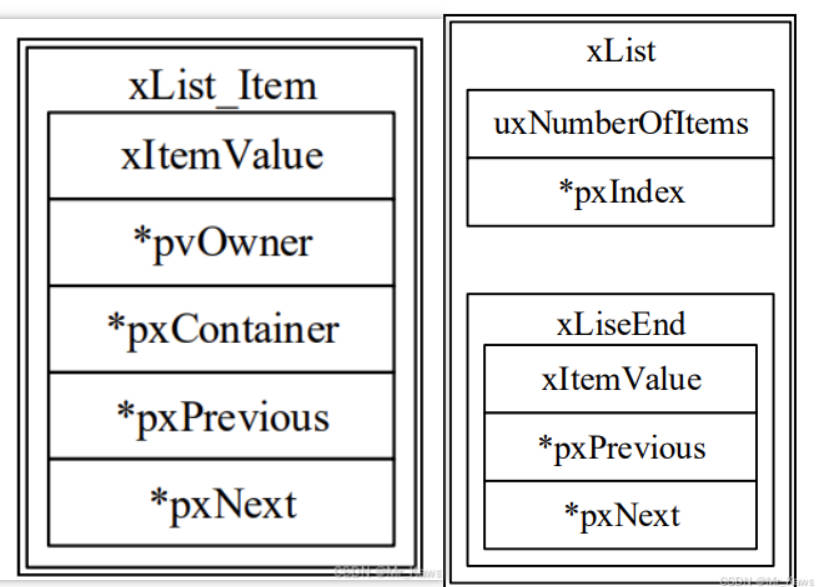
假如现在的列表项如下:

此时我们要将 50 插入到列表中去

此时pxNewListItem指向的就是50这一项,pxIterator指向的就是40这一项。
由上面的for循环也可以看出 pxIterator->pxNext->xItemValue <= xValueOfInsertion; 列表中的值小于等于当要插入的值,插入点就继续指向下一个。
此时要插入的值是50,它会依次和列表中的值20、30、40、60比较,当比较到60时,插入点的值是60,大于要插入的值50,此时for循环退出,插入点指向40这一项。 此时列表的状态入下图所示
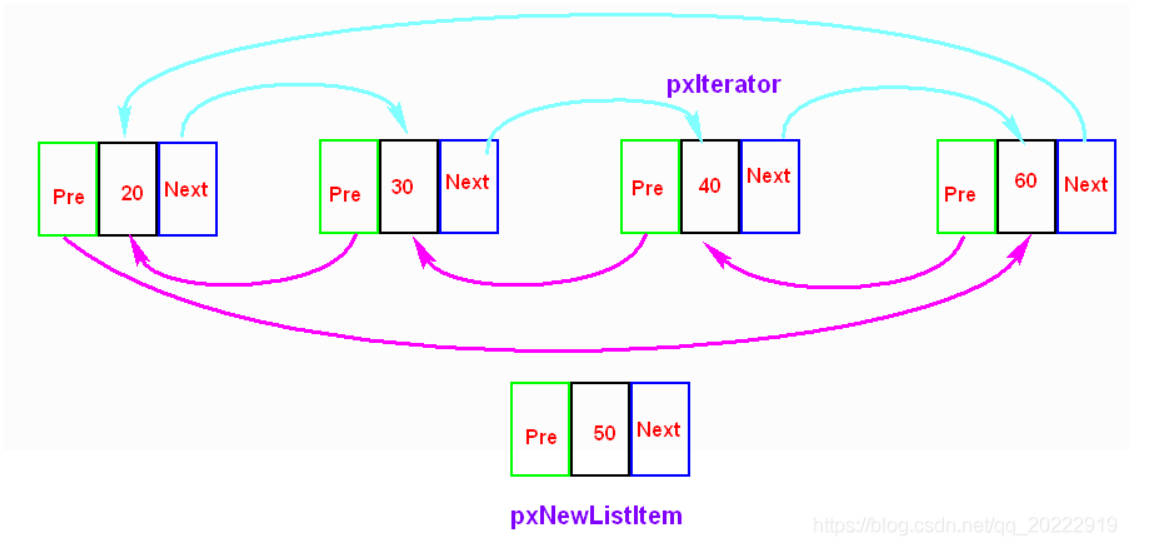
下来开始执行列表插入操作。
pxNewListItem->pxNext = pxIterator->pxNext;//50->next->60
将插入点指向的下一个列表项赋值给新插入列表项的下一项
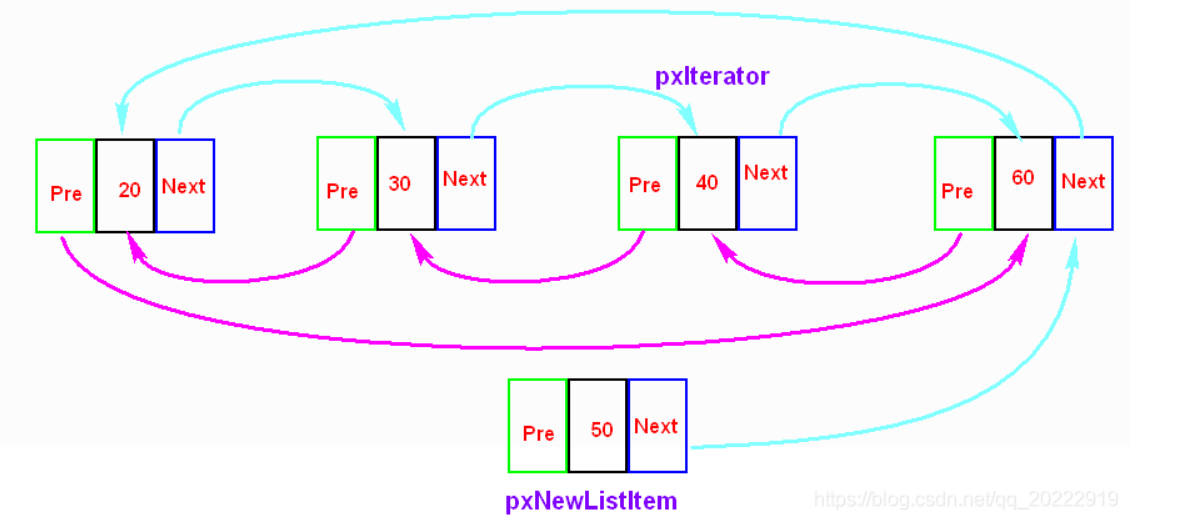
此时列表项50的下一项指向了列表项60.
pxNewListItem->pxNext->pxPrevious = pxNewListItem;//pxNewListItem->pxNext就是60 60->pre ->50
将新插入列表项的下一项的前一项设置为新插入列表项。
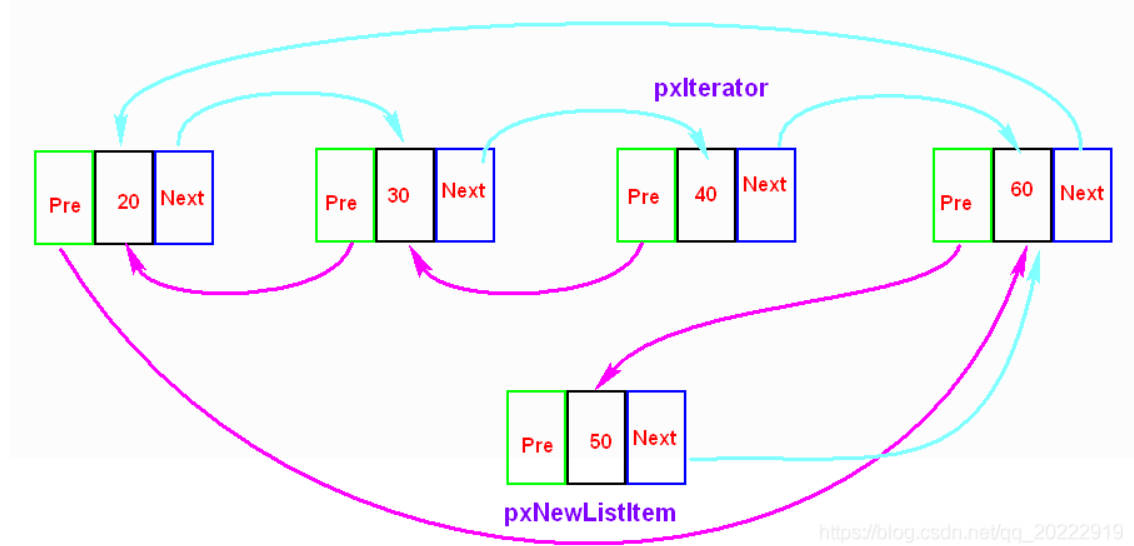
也就是说此时列表项60的上一个列表项指向了50。
pxNewListItem->pxPrevious = pxIterator;
下来将新插入列表项的前一个列表项设置为插入点。

此时列表项50的前一项指向了40。
pxIterator->pxNext = pxNewListItem;
将新插入列表项指向插入点的下一项
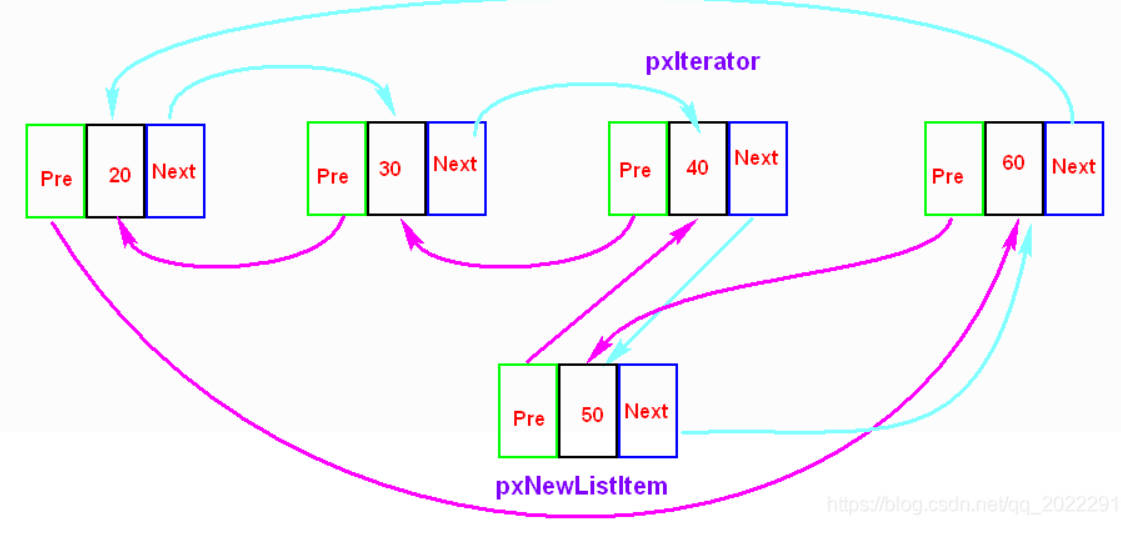
此时列表项40的下一项是列表项50,列表项50的下一项是60。列表项60的前一项是列表项50,列表项50的前一项是列表项40。 pxNewListItem->pvContainer = ( void * ) pxList: 插入后,列表项成员变量pvContainer记录此列表项属于哪个列表。 pxList->uxNumberOfItems:列表成员数量加1。 这样列表项50就成功的插入到列表中去了,插入的过程就是将插入点与后面的连接项断开,然后重新连接到新插入项上。在把新插入项和断开的连接项连接起来。
C语言链表基础
Blog 参考 https://yufengbiji.com/posts/data-structures-02
链表的创建
定义表示节点的结构体
struct node {
/* 后继节点 */
struct node *next;
/* 值 */
int data;
};
////定义结点结构体
typedef struct node
{
/* data:数据域*/
int num;
int score;
char name[20];
/* point:指针域 指针需要指向的地址 后继节点*/
struct node *next;
} Node;在后面的代码书写中,
Node就等价于struct node了。 比如我们使用这个结构体创建一个新的节点,Node *new_node就等价于struct node *new_node。单链表的节点

单链表的表示
单链表是线性表的链式表示和实现。把节点链接起来,就形成了单链表。

单链表的创建
list * create_list()
{
/* 创建一个新的节点,由于使用了typedef关键字,此处 node *head与struct node *head等价 */
list *head = (list *)malloc(sizeof(list));
if(head==NULL) return NULL;
/* 初始化节点 */
head->data = 0; // 头结点数据域,我们用来表示链表长度
head->next = NULL;
return head;
}

此函数会创建一个单链表,并返回头指针。 头指针是指向头结点地址的指针,和节点中指向下一个节点的指针是相同类型。
首先,我们用malloc函数开辟了一块list大小的内存,并返回了指向该内存块首地址的指针,同时将此指针赋值给头指针变量。
接着,判断此指针是否为空,为空,则说明内存申请失败(一般不会)。
然后,对该节点进行初始化。
最后,函数返回头指针,结束。
为什么设置头节点? 头节点的数据域一般无意义,这里为了方便后面的插入和删除操作而设置,头节点并非链表所必须。 头节点后面的第一个元素节点,称为首元节点
// 链表的创建
void link_creat_head(Node ** p_head,Node *p_new)
{
Node *p_mov = *p_head; //当第一次加入链表为空时,head执行p_new
if (*p_head == NULL)
{
*p_head = p_new;
p_new->next = NULL;
}
else //第二次及以后加入链表
{
while (p_mov->next!=NULL) //找到原有链表的最后一个节点
{
p_mov = p_mov->next;
}
p_mov->next = p_new; //将新申请的节点加入链表
p_new->next = NULL;
}
}
//链表的遍历
void link_print(Node *head)
{
Node *p_mov; //定义新的指针保存链表的首地址,防止使用head改变原本链表
p_mov = head; //当指针保存最后一个结点的指针域为NULL时,循环结束
while(p_mov!=NULL)
{
//先打印当前指针保存结点的指针域
printf("num=%d score=%d name:%s\n",p_mov->num,\
p_mov->score,p_mov->name);
//指针后移,保存下一个结点的地址
p_mov = p_mov->next;
}
}
//链表的释放
void link_free(Node **p_head)
{
//定义一个指针变量保存头结点的地址
Node *pb=*p_head;
while(*p_head!=NULL)
{
//先保存p_head指向的结点的地址
pb=*p_head;
//p_head保存下一个结点地址
*p_head=(*p_head)->next;
//释放结点并防止野指针
free(pb);
pb = NULL;
}
}
单链表基本操作
2.1 单链表的插入

2.2 单链表的删除

2.3 单链表的查找
先对比第一个结点的数据域是否是想要的数据,如果是就直接返回,如果不是则继续查找下 一个结点,如果到达最后一个结点的时候都没有匹配的数据,说明要查找数据不存在
.....
//链表的查找
//按照num查找
Node * link_search_num(Node *head,int num)
{
Node *p_mov;
//定义的指针变量保存第一个结点的地址
p_mov=head;
//当没有到达最后一个结点的指针域时循环继续
while(p_mov!=NULL)
{
//如果找到是当前结点的数据,则返回当前结点的地址
if(p_mov->num == num)//找到了
{
return p_mov;
}
//如果没有找到,则继续对比下一个结点的指针域
p_mov=p_mov->next;
}
//当循环结束的时候还没有找到,说明要查找的数据不存在,返回NULL进行标识
return NULL;//没有找到
}
//按照name查找
Node * link_search_name(Node *head,char *name)
{
Node *p_mov;
p_mov=head;
while(p_mov!=NULL)
{
if(strcmp(p_mov->name,name)==0)//找到了
{
return p_mov;
}
p_mov=p_mov->next;
}
return NULL;//没有找到
}
//链表的插入:按照num的顺序插入
void link_insert_num(Node **p_head,Node *p_new)
{
Node *pb,*pf;
pb=pf=*p_head;
if(*p_head ==NULL)// 链表为空链表
{
*p_head = p_new;
p_new->next=NULL;
return ;
}
while((p_new->num >= pb->num) && (pb->next !=NULL) )
{
pf=pb;
pb=pb->next;
}
if(p_new->num < pb->num)//找到一个节点的num比新来的节点num大,插在pb的前面
{
if(pb== *p_head)//找到的节点是头节点,插在最前面
{
p_new->next= *p_head;
*p_head =p_new;
}
else
{
pf->next=p_new;
p_new->next = pb;
}
}
else//没有找到pb的num比p_new->num大的节点,插在最后
{
pb->next =p_new;
p_new->next =NULL;
}
}
//链表的排序
void link_order(Node *head)
{
Node *pb,*pf,temp;
pf=head;
if(head==NULL)
{
printf("The list is empty and does not need to be sorted\n");
return ;
}
if(head->next ==NULL)
{
printf("Only one node, no sorting\n");
return ;
}
while(pf->next !=NULL) //以pf指向的节点为基准节点,
{
pb=pf->next ; //pb从基准元素的下个元素开始
while(pb!=NULL)
{
if(pf->num > pb->num) //判断num的大小去排序
{
temp=*pb;
*pb=*pf;
*pf=temp;
temp.next=pb->next;
pb->next=pf->next;
pf->next=temp.next;
}
pb=pb->next;
}
pf=pf->next;
}
}
//链表结点的删除
void link_delete_num(Node **p_head,int num)
{
Node *pb,*pf;
pb=pf=*p_head;
if(*p_head == NULL)//链表为空,不用删
{
printf("The list is empty and there are no nodes to delete");\
return ;
}
while(pb->num != num && pb->next !=NULL)//循环找,要删除的节点
{
pf=pb;
pb=pb->next;
}
if(pb->num == num)//找到了一个节点的num和num相同
{
if(pb == *p_head)//要删除的节点是头节点
{
*p_head = pb->next;//让保存头结点的指针保存后一个结点的地址
}
else
{
pf->next = pb->next;//前一个结点的指针域保存要删除的后一个结点的地址
}
//释放空间
free(pb);
pb = NULL;
}
else//没有找到
{
printf("There are no nodes to delete\n");
}
}
- 代码测试
int main()
{
Node *head = NULL, *p_new =NULL;
int num,i;
printf("Please enter the initial number of linked list:\n");
scanf("%d",&num);
for (i = 0;i<num;i++)
{
p_new = (Node*) malloc(sizeof(Node));
printf("Iint num,socre,name \n");
scanf("%d %d %s",&p_new->num,&p_new->score,&p_new->name);
link_creat_head(&head,p_new);
}
link_print(head);
#if 0
Node *pb;
while(1)
{
printf("Please enter the number you are looking for \n");
scanf("%d",&num);
pb=link_search_num(head,num);
if(pb!=NULL)//找到了
{
printf("Found it. num=%d score=%d name:%s\n",pb->num,pb->score,pb->name);
}
else
{
printf("The node you were looking for was not found \n");
}
}
#endif
#if 0
char name[32] = "";
Node *pb;
while(1)
{
printf("Please enter the name you are looking for\n");
scanf("%s",name);
pb=link_search_name(head,name);
if(pb!=NULL)//找到了
{
printf("Found it. num=%d score=%d name:%s\n",pb->num,pb->score,pb->name);
}
else
{
printf("The node you were looking for was not found\n");
}
}
#endif
#if 0
printf("Enter the number of the node you want to delete\n");
scanf("%d",&num);
link_delete_num(&head,num);
link_print(head);
#endif
#if 0
while(1)
{
printf("Enter the num-score-name of the node you want to insert\n");
p_new=(Node*)malloc(sizeof(Node));//申请一个新节点
scanf("%d %d %s",&p_new->num,&p_new->score,p_new->name);
link_insert_num(&head,p_new);
link_print(head);
}
#endif
#if 0
printf("***************************\n");
link_order(head);
link_print(head);
#endif
link_free(&head);
return 0;
}
